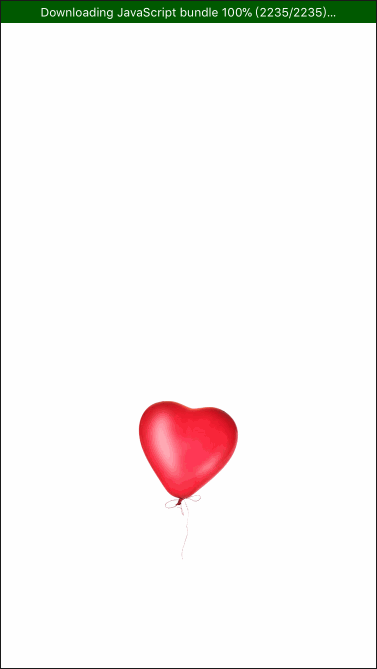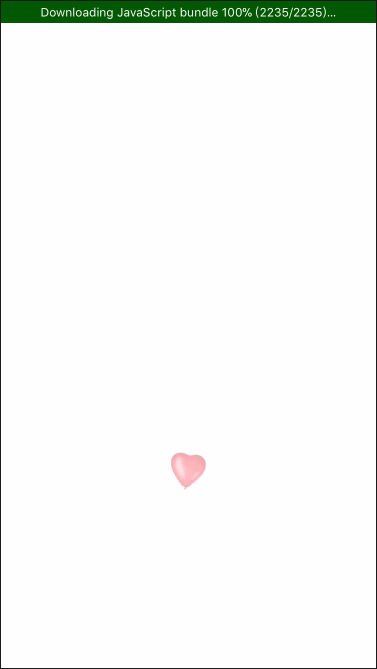原文地址:https://github.com/SmallStoneSK/Blog/issues/1
1. 前言
近日,被安排做一个开场动画的任务。虽然RN提供了Animated来自定义动画,但是本次动画中的元素颇多,交互甚烦。。。在完成任务的同时,发现很多步骤其实是重复的,于是封装了一个小组件记录一下,分享给大家。
2. 初步尝试
分析一下:虽然这次的动画需求步骤挺多的,但是把每一步动画拆解成step1, step2, step3, step4... 讲道理应该还是能够实现的吧?嗯,用Animated.Value()创建值,然后再配上Animated.timing应该就好了。
想到这,反手就是创建一个demo.js,先做个往上飘的气球试试先吧。
export class Demo1 extends PureComponent {
constructor(props) {
super(props);
}
componentWillMount() {
this._initAnimation();
}
componentDidMount() {
this._playAnimation();
}
_initAnimation() {
this.topAnimatedValue = new Animated.Value(400);
this.balloonStyle = {
position: 'absolute',
left: 137.5,
top: this.topAnimatedValue.interpolate({
inputRange: [-999999, 999999],
outputRange: [-999999, 999999]
})
};
}
_playAnimation() {
Animated.timing(this.topAnimatedValue, {
toValue: 200,
duration: 1500
}).start();
}
render() {
return (
<View style={styles.demoContainer}>
<Animated.Image
style={[styles.balloonImage, this.balloonStyle]}
source={require('../../pic/demo1/balloon.png')}
/>
</View>
);
}
}

当然,这是再简单不过的基础动画了。。。如果我们让这里的气球一开始最好先是从底部的一个点放大,并且有一个渐入的效果,完了之后再往上飘,这该怎么实现呢?于是代码变成了这样:
export class Demo1 extends PureComponent {
...
_interpolateAnimation(animatedValue, inputRange, outputRange) {
return animatedValue.interpolate({inputRange, outputRange});
}
_initAnimation() {
this.opacityAnimatedValue = new Animated.Value(0);
this.scaleAnimatedValue = new Animated.Value(0);
this.topAnimatedValue = new Animated.Value(400);
this.balloonStyle = {
position: 'absolute',
left: 137.5,
opacity: this._interpolateAnimation(this.opacityAnimatedValue, [0, 1], [0, 1]),
top: this._interpolateAnimation(this.topAnimatedValue, [-999999, 999999], [-999999, 999999]),
transform:[{scale: this._interpolateAnimation(this.scaleAnimatedValue, [0, 1], [0, 1])}]
};
}
_playAnimation() {
Animated.sequence([
this.step1(),
this.step2()
]).start();
}
step1() {
return Animated.parallel([
Animated.timing(this.opacityAnimatedValue, {
toValue: 1,
duration: 500
}),
Animated.timing(this.scaleAnimatedValue, {
toValue: 1,
duration: 500
})
]);
}
step2() {
return Animated.timing(this.topAnimatedValue, {
toValue: 200,
duration: 1500
});
}
...
}

插句话:在动画衔接的时候,还是纠结了一下。因为Animated提供的方法还是比较多的,这里用到了sequence、parallel,分别可以让动画顺序执行和并行。除此之外,animtaion的start方法是支持传入一个回调函数的,表示在当前动画运行结束的时候会触发这个回调。所以我们还可以这么写:
_playAnimation() {
this.step1(() => this.step2()); // 不同之处1:step2作为step1动画结束之后的回调传入
}
step1(callback) {
Animated.parallel([
Animated.timing(this.opacityAnimatedValue, {
toValue: 1,
duration: 500
}),
Animated.timing(this.scaleAnimatedValue, {
toValue: 1,
duration: 500
})
]).start(() => {
callback && callback(); // 不同之处2:调用传入的回调
});
}
step2() {
Animated.timing(this.topAnimatedValue, {
toValue: 200,
duration: 1500
}).start();
}
虽然同样能够实现效果,但是还是觉得这种方式不是很舒服,所以弃之。。。
到这里,我们已经对这个气球做了渐变、放大、平移等3项操作。但是,如果有5个气球,还有其他各种元素又该怎么办呢?这才一个气球我们就已经用了opacityAnimatedValue,scaleAnimatedValue,topAnimatedValue三个变量来控制,更多的动画元素那直就gg,不用下班了。。。
3. 实现升级
说实话,要做这么个东西,怎么就那么像在做一个PPT呢。。。
“屏幕就好比是一张PPT背景图;每一个气球就是PPT上的元素;你可以通过拖动鼠标来摆放各个气球,我可以用绝对定位来确定每个气球的位置;至于动画嘛,刚才的demo已经证明并不难实现,无非就是控制透明度、xy坐标、缩放比例罢了。”
想到这,心中不免一阵窃喜。哈哈,有路子了,可以对PPT上的这些元素封装一个通用的组件,然后提供常用的一些动画方法,剩下的事情就是调用这些动画方法组装成更复杂的动画了。新建一个PPT:“出现、飞跃、淡化、浮入、百叶窗、棋盘。。。”看着这令人眼花缭乱的各种动画,我想了下:嗯,我还是从最简单的做起吧。。。
首先,我们可以将动画分成两种:一次性动画和循环动画。
其次,作为一个元素,它可以用作动画的属性主要包括有:opacity, x, y, scale, angle等(这里先只考虑了二维平面的,其实还可以延伸扩展成三维立体的)。
最后,基本动画都可以拆解为这几种行为:出现/消失、移动、缩放、旋转。
3.1 一次性动画
想到这,反手就是创建一个新文件,代码如下:
// Comstants.js
export const INF = 999999999;
// Helper.js
export const Helper = {
sleep(millSeconds) {
return new Promise(resolve => {
setTimeout(() => resolve(), millSeconds);
});
},
animateInterpolate(animatedValue, inputRange, outputRange) {
if(animatedValue && animatedValue.interpolate) {
return animatedValue.interpolate({inputRange, outputRange});
}
}
};
// AnimatedContainer.js
import {INF} from "./Constants";
import {Helper} from "./Helper";
export class AnimatedContainer extends PureComponent {
constructor(props) {
super(props);
}
componentWillMount() {
this._initAnimationConfig();
}
_initAnimationConfig() {
const {initialConfig} = this.props;
const {opacity = 1, scale = 1, x = 0, y = 0, rotate = 0} = initialConfig;
// create animated values: opacity, scale, x, y, rotate
this.opacityAnimatedValue = new Animated.Value(opacity);
this.scaleAnimatedValue = new Animated.Value(scale);
this.rotateAnimatedValue = new Animated.Value(rotate);
this.xAnimatedValue = new Animated.Value(x);
this.yAnimatedValue = new Animated.Value(y);
this.style = {
position: 'absolute',
left: this.xAnimatedValue,
top: this.yAnimatedValue,
opacity: Helper.animateInterpolate(this.opacityAnimatedValue, [0, 1], [0, 1]),
transform: [
{scale: this.scaleAnimatedValue},
{rotate: Helper.animateInterpolate(this.rotateAnimatedValue, [-INF, INF], [`-${INF}rad`, `${INF}rad`])}
]
};
}
show() {}
hide() {}
scaleTo() {}
rotateTo() {}
moveTo() {}
render() {
return (
<Animated.View style={[this.style, this.props.style]}>
{this.props.children}
</Animated.View>
);
}
}
AnimatedContainer.defaultProps = {
initialConfig: {
opacity: 1,
scale: 1,
x: 0,
y: 0,
rotate: 0
}
};
第一步的骨架这就搭好了,简单到自己都难以置信。。。接下来就是具体实现每一个动画的方法了,先拿show/hide开刀。
show(config = {opacity: 1, duration: 500}) {
Animated.timing(this.opacityAnimatedValue, {
toValue: config.opacity,
duration: config.duration
}).start();
}
hide(config = {opacity: 0, duration: 500}) {
Animated.timing(this.opacityAnimatedValue, {
toValue: config.opacity,
duration: config.duration
}).start();
}
试了一下,简直是文美~
但是!仔细一想,却有个很严重的问题,这里的动画衔接该怎处理?要想做一个先show,然后过1s之后再hide的动画该怎么实现?貌似又回到了一开始考虑过的问题。不过这次,我却是用Promise来解决这个问题。于是代码又变成了这样:
sleep(millSeconds) {
return new Promise(resolve => setTimeout(() => resolve(), millSeconds));
}
show(config = {opacity: 1, duration: 500}) {
return new Promise(resolve => {
Animated.timing(this.opacityAnimatedValue, {
toValue: config.opacity,
duration: config.duration
}).start(() => resolve());
});
}
hide(config = {opacity: 0, duration: 500}) {
return new Promise(resolve => {
Animated.timing(this.opacityAnimatedValue, {
toValue: config.opacity,
duration: config.duration
}).start(() => resolve());
});
}
现在我们再来看刚才的动画,只需这样就能实现:
playAnimation() {
this.animationRef
.show() // 先出现
.sleep(1000) // 等待1s
.then(() => this.animationRef.hide()); // 消失
}
甚至还可以对createPromise这个过程再封装一波:
_createAnimation(animationConfig = []) {
const len = animationConfig.length;
if (len === 1) {
const {animatedValue, toValue, duration} = animationConfig[0];
return Animated.timing(animatedValue, {toValue, duration});
} else if (len >= 2) {
return Animated.parallel(animationConfig.map(config => {
return this._createAnimation([config]);
}));
}
}
_createAnimationPromise(animationConfig = []) {
return new Promise(resolve => {
const len = animationConfig.length;
if(len <= 0) {
resolve();
} else {
this._createAnimation(animationConfig).start(() => resolve());
}
});
}
opacityTo(config = {opacity: .5, duration: 500}) {
return this._createAnimationPromise([{
toValue: config.opacity,
duration: config.duration,
animatedValue: this.opacityAnimatedValue
}]);
}
show(config = {opacity: 1, duration: 500}) {
this.opacityTo(config);
}
hide(config = {opacity: 0, duration: 500}) {
this.opacityTo(config);
}
然后,我们再把其他的几种基础动画(scale, rotate, move)实现也加上:
scaleTo(config = {scale: 1, duration: 1000}) {
return this._createAnimationPromise([{
toValue: config.scale,
duration: config.duration,
animatedValue: this.scaleAnimatedValue
}]);
}
rotateTo(config = {rotate: 0, duration: 500}) {
return this._createAnimationPromise([{
toValue: config.rotate,
duration: config.duration,
animatedValue: this.rotateAnimatedValue
}]);
}
moveTo(config = {x: 0, y: 0, duration: 1000}) {
return this._createAnimationPromise([{
toValue: config.x,
duration: config.duration,
animatedValue: this.xAnimatedValue
}, {
toValue: config.y,
duration: config.duration,
animatedValue: this.yAnimatedValue
}]);
}
3.2 循环动画
一次性动画问题就这样解决了,再来看看循环动画怎么办。根据平时的经验,一个循环播放的动画一般都会这么写:
roll() {
this.rollAnimation = Animated.timing(this.rotateAnimatedValue, {
toValue: Math.PI * 2,
duration: 2000
});
this.rollAnimation.start(() => {
this.rotateAnimatedValue.setValue(0);
this.roll();
});
}
play() {
this.roll();
}
stop() {
this.rollAnimation.stop();
}
没错,就是在一个动画的start中传入回调,而这个回调就是递归地调用播放动画本身这个函数。那要是对应到我们要封装的这个组件,又该怎么实现呢?
思考良久,为了保持和一次性动画API的一致性,我们可以给animatedContainer新增了以下几个函数:
export class AnimatedContainer extends PureComponent {
...
constructor(props) {
super(props);
this.cyclicAnimations = {};
}
_createCyclicAnimation(name, animations) {
this.cyclicAnimations[name] = Animated.sequence(animations);
}
_createCyclicAnimationPromise(name, animations) {
return new Promise(resolve => {
this._createCyclicAnimation(name, animations);
this._playCyclicAnimation(name);
resolve();
});
}
_playCyclicAnimation(name) {
const animation = this.cyclicAnimations[name];
animation.start(() => {
animation.reset();
this._playCyclicAnimation(name);
});
}
_stopCyclicAnimation(name) {
this.cyclicAnimations[name].stop();
}
...
}
其中,_createCyclicAnimation,_createCyclicAnimationPromise是和一次性动画的API对应的。但是,不同点在于传入的参数发生了很大的变化:animationConfg -> (name, animations)
- name是一个标志符,循环动画之间不能重名。_playCyclicAnimation和_stopCyclicAnimation都是通过name来匹配相应animation并调用的。
- animations是一组动画,其中每个animation是调用_createAnimation生成的。由于循环动画可以是由一组一次性动画组成的,所以在_createCyclicAnimation中也是直接调用了Animated.sequence,而循环播放的实现就在于_playCyclicAnimation中的递归调用。
到这里,循环动画基本也已经封装完毕。再来封装两个循环动画roll(旋转),blink(闪烁)试试:
blink(config = {period: 2000}) {
return this._createCyclicAnimationPromise('blink', [
this._createAnimation([{
toValue: 1,
duration: config.period / 2,
animatedValue: this.opacityAnimatedValue
}]),
this._createAnimation([{
toValue: 0,
duration: config.period / 2,
animatedValue: this.opacityAnimatedValue
}])
]);
}
stopBlink() {
this._stopCyclicAnimation('blink');
}
roll(config = {period: 1000}) {
return this._createCyclicAnimationPromise('roll', [
this._createAnimation([{
toValue: Math.PI * 2,
duration: config.period,
animatedValue: this.rotateAnimatedValue
}])
]);
}
stopRoll() {
this._stopCyclicAnimation('roll');
}
4. 实战
忙活了大半天,总算是把AnimatedContainer封装好了。先找个素材练练手吧~可是,找个啥呢?“叮”,只见手机上挖财的一个提醒亮了起来。嘿嘿,就你了,挖财的签到页面真的很适合(没有做广告。。。)效果图如下:

渲染元素的render代码就不贴了,但是我们来看看动画播放的代码:
startOpeningAnimation() {
// 签到(一次性动画)
Promise
.all([
this._header.show(),
this._header.scaleTo({scale: 1}),
this._header.rotateTo({rotate: Math.PI * 2})
])
.then(() => this._header.sleep(100))
.then(() => this._header.moveTo({x: 64, y: 150}))
.then(() => Promise.all([
this._tips.show(),
this._ladder.sleep(150).then(() => this._ladder.show())
]))
.then(() => Promise.all([
this._today.show(),
this._today.moveTo({x: 105, y: 365})
]));
// 星星闪烁(循环动画)
this._stars.forEach(item => item
.sleep(Math.random() * 2000)
.then(() => item.blink({period: 1000}))
);
}
光看代码,是不是就已经脑补整个动画了~ 肥肠地一目了然,真的是美滋滋。
5. 后续思考
-
讲道理,现在这个AnimatedContainer能够创建的动画还是稍显单薄,仅包含了最基础的一些基本操作。不过,这也说明了还有很大的扩展空间,根据_createCyclicAnimationPromise和_createAnimationPromise这两个函数,可以自由地封装我们想要的各种复杂动画效果。而调用方就只要通过promise的all和then方法来控制动画顺序就行了。个人感觉,甚至有那么一丁点在使用jQuery。。。
-
除此之外,还有一个问题就是:由于这些元素都是绝对定位布局的,那这些元素的x, y坐标值怎么办?在有视觉标注稿的前提下,那感觉还可行。但是一旦元素的数量上去了,那在使用上还是有点麻烦的。。。所以啊,要是有个什么工具能够真的像做PPT一样,支持元素拖拽并实时获得元素的坐标,那就真的是文美了。。。。。。
老规矩,本文代码地址:github.com/SmallStoneS…